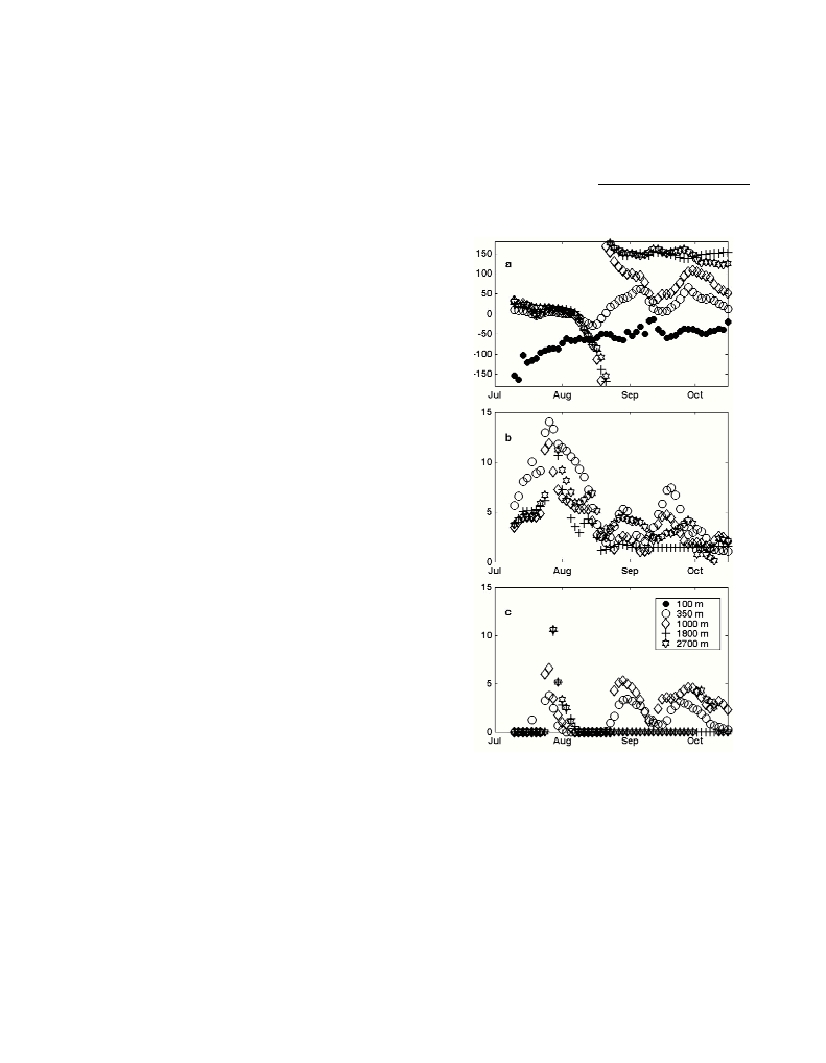EVIDENCE THAT ALGERIAN EDDIES HAVE AN ANTICYCLONIC STRUCTURE THAT CAN EXTEND
FOR MONTHS OVER THE WHOLE DEPTH (~2700 M)
E. Aubertin
1
, C.Millot
1*
, I. Taupier-Letage
1
and J. Font
2
1
Laboratoire d’Océanographie et de Biogéochimie, Antenne LOB-COM-CNRS, BP 330, F-83507 La Seyne-sur-Mer, France
*cmillot@ifremer.fr
2
Physical Oceanography Group, CMIMA – CSIC, Passeig Maritim, SP- 08003, Barcelona, Spain
Abstract
The ~40 currentmeters deployed on 9 moorings for 1 year during the 1997-1998 ELISA experiment (www
.com.uni
v-mrs.fr/ELISA/
, 1)
have shown that meso-scale Algerian Eddies (AEs) can extend over the whole depth. Simple realistic hypotheses about the linear
combination of currents due to the AEs and to the large-scale circulation allow validating the hypothesis (2) that the AEs’structure can be
anticyclonic for months over the whole depth with currents similar over the whole deeper layer (350 to 2700 m).
Rapp. Comm. int. Mer Médit., 37,2004
82
The Algerian Current (~50 km width, 100-200 m thickness, ~1 Sv
transport) is markedly unstable (3). Infrared images (4) and current
time series (5) have allowed specifying that two kinds of mesoscale
features can be generated. One kind is considered as a series of paired
cyclones and anticyclones (diameter up to 50-100 km) that propagate
downstream at a few km/d and that do not have a large vertical extent
(5). Simple analytical models (3), and sophisticated numerical
computations as well (e.g. 6), suggest that these eddies result from a
baroclinic instability process.
The other kind named event (5) is considered, in the surface layer,
as a large meander (50-100 km amplitude) of the Algerian Current
embedding an anticyclone and generating a short-lived (a few weeks)
cyclone upstream from the meander’s crest (2, 7, 8). Both in situ
observations (5, 9) and laboratory experiments (7) support the
hypothesis (2) that the circulation is anticyclonic in the whole deeper
layer too. This is not consistent with a baroclinic instability process
and might rather be created by a pressure gradient in the surface layer
(i.e. a surface bump not compensated enough by the interface
lowering; 7). Events are generated a few times a year only and can
propagate downstream for months along the Algerian slope. They
generally detach seawards at the entrance of the channel of Sardinia,
and can then follow, during up to 3 years at least (10), an
anticlockwise circuit in the eastern Algerian subbasin. Since the
meander can then no longer be differentiated from the surface
anticyclone, these eddies (diameters up to 200-250 km) are named
Algerian Eddies (AEs).
The ELISA current time series have clearly demonstrated (11) that
the mesoscale AEs sometimes extend down to the bottom (~2700 m)
and are stronger than the large-scale circulation, thus reversing from
eastwards to westwards the current measured at depth off Algeria. To
better specify the deep structure of the AEs, we hypothesise that the
meso- and large-scale currents combine linearly. We thus decompose,
when possible, the currents measured at depth into a component
oriented as the yearly mean current, expected to represent the large
scale, and a component oriented as the current measured
simultaneously at 100 m. The later being generally parallel to the
surface isotherms, it mainly represents the mesoscale when within an
AE. For instance, at point 3 in July-August (figure), currents
measured at 350, 1000, 1800 and 2700 m are roughly oriented as the
current at 100 m (a: direction at 100 m (0°for northwards and +90°
for eastwards) and phases with respect to 100 m (positive when
clockwise)). While the 100-m direction is changing due to the AE (96-
1) propagation, the meso-scale components at depth remain in phase
and have similar intensities (b, 5-15 cm/s) much larger than the large-
scale ones (c, < 5cm/s). These features clearly account for the overall
anticyclonic structure of 96-1 at that time (as supported by
unpublished hydrological data). In September-October, while 96-1
was still over point 3, phases with respect to 100 m changed, but
others (350/1000, 1800/2700) were rather constant, thus accounting
for a coherent although more complex structure of 96-1 over the
whole depth.
References
1-Taupier-Letage I., I. Puillat, P. Raimbault and C. Millot, 2003.
Biological response to mesoscale eddies in the Algerian Basin. J.
Geophys. Res., 108, C8: 3245, doi:10.1029/1999JC000117, 2003.
2-Millot C., 1994. Models and data: a synergetic approach in the western
Mediterranean Sea. Pp. 407-425. In: P. Malanotte-Rizzoli and A.R.
Robinson Eds., Erice School Proceedings, “Ocean Processes in Climate
Dynamics: Global and Mediterranean Examples”.
3-Millot C., 1985. Some features of the Algerian Current. J. Geophys.
Res., 90, C4: 7169-7176.
4-Taupier-Letage I. and C. Millot, 1988. Surface circulation in the
Algerian Basin during 1984. Oceanol. Acta,sp. n°9: 119-131.
5-Millot C., I. Taupier-Letage and M. Benzohra, 1997. Circulation off
Algeria inferred from the Médiprod-5 current meters. Deep-Sea Res.,44,
9-10: 1467-1495.
6-Beckers J.-M. and J. Nihoul,1992. Model of the Algerian Current’s
instability. J. Mar. Sys.,3, 4-5: 441-451.
7-Obaton D., C. Millot, G. Chabert D’Hières and I. Taupier-Letage,
2000. The Algerian Current: comparisons between in situand laboratory
measurements. Deep-Sea Res.,I 47: 2159-2190.
8-Salas J., C. Millot, J. Font and E. García-Ladona, 2002. Analysis of
mesoscale phenomena in the Algerian Basin observed with drifting buoys
and infrared images. Deep-Sea Res., 49, 2: 245-266.
9-Ruiz S., J. Font, M.Emelianov, J. Isern-Fontanet, C. Millot and I.
Taupier-Letage, 2002. Deep structure of an open sea eddy in the Algerian
Basin. J. Mar. Sys.,33-34: 179-195.
10-Puillat I., I. Taupier-Letage and C. Millot. Algerian eddies lifetimes
can near 3 years, 2002. J. Mar. Syst.,31, 4: 245-259.
11-Millot C. and I. Taupier-Letage, 2003. Additional evidence of LIW
entrainment across the Algerian Basin by mesoscale eddies and not by a
permanent westward-?owing vein. Progress in Oceanography, accepted.

